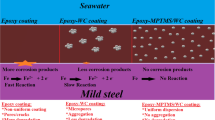Abstract
Generally film coatings are formulated by accounting average weather conditions, corrosivity level and any metal substrate, while accelerated (salt spray) test usually considered adequate to predict performance of a coating system. This established a need to evaluate compatibility of a coating system to a particular operational conditions for preservation of underlaying substrate metal. In this communication, epoxy-polyamide primer and coal tar epoxy topcoat system were tested for preservation of mild steel under various natural exposures including marine, industrial and urban test sites of Karachi city, while accelerated test was also conducted for comparison. Condition of coating was assessed by visual morphological inspection, gloss measurements, scanning electron microscopy (SEM), energy-dispersive X-ray analysis and by oxygen/carbon ratios. Resulted data were statistically analyzed through principal component analysis and explained a variance of 99.82 % when two components were considered. Severe blistering, acute loss of gloss and high degradation in the surface characteristics of coal tar epoxy coating systems were noticed after natural exposure testing at marine and industrial sites as compared to accelerated (salt spray) testing. However, comparison of performance of coal tar epoxy coating systems applied on mild steel with our previous study on electrogalvanized mild steel has shown faintly better preservability of mild steel samples by coal tar epoxy coating systems. This was also proved by relatively lower oxygen/carbon ratios for the coating systems applied on mild steel which correspond to lower coating degradation products.
Similar content being viewed by others
References
Fuente D.D., Díaz I., Simancas J., Chico B., Morcillo M.: Long-term atmospheric corrosion of mild steel. Corros. Sci. 53, 604–617 (2011)
Lakshminarayanan A.K., Balasubramanian V., Salahuddin M.: Microstructure, tensile and impact toughness properties of friction stir welded mild steel. J. Iron Steel Res. 17, 68–74 (2010)
Karthik, D.; Tamilvendan, D.; Prabhu, G.V.: Study on the inhibition of mild steel corrosion by 1,3-bis-(morpholin-4-ylphenyl-methyl)-thiourea in hydrochloric acid medium. J. Saudi Chem. Soc. (2011). doi:10.1016/j.jscs.2011.10.009
Kim D.K., Muralidharan S., Ha T., Bae J.H., Ha Y.C., Lee J.D., Scantlebury H.G.: Electrochemical studies on the alternating current corrosion of mild steel under cathodic protection condition in marine environments. Electrochim. Acta. 51, 5259–5267 (2006)
Tüken T., Arslan G., Yazıcı B., Erbil M.: The corrosion protection of mild steel by polypyrrole/polyphenol multilayer coating. Corros. Sci. 46, 2743–2754 (2004)
Gu X., Sung L., Kidah B., Oudina M., Clerici C., Hu H. Stanley, Byrd D.W.E., Jean J.Y.C., Nguyen T., Martin J.W.: Multiscale physical characterization of an outdoor-exposed polymeric coating system. J. Coat. Technol. Res. 6, 67–72 (2009)
Fay F., Linossier I., Langlois V., Haras D., Rehel K.V.: SEM and EDX analysis: two powerful techniques for the study of antifouling paints. Prog. Org. Coat. 54, 216–223 (2005)
Weldon D.G.: Failure Analysis of Paints and Coatings. Wiley, New York (2002)
Sorensen P.A., Kill S., Johansen D., Weinell C.E.: Anticorrosive coatings: a review. J. Coat. Technol. Res. 6, 135–139 (2009)
Bano H., Khan M.I., Kazmi S.A.: Structure and microstructure studies of epoxy coating after natural exposure testing. J. Chem. Soc. Pak. 33, 454–463 (2011)
Bano H., Khan M.I., Kazmi S.A.: SEM-EDX and FTIR studies of chlorinated rubber coating. J. Chem. Soc. Pak. 35, 95–108 (2013)
Bano H., Khan M.I., Kazmi S.A.: Studies in accelerated (predicted) versus observed anticorrosive performance for coastal industrialized location. J. Chem. Soc. Pak. 35, 703–716 (2013)
SSPC-SP1: Solvent cleaning: standard for the removal of surface contaminants by the use of solvent. Pittsburgh, PA, USA (2004)
ASTM B-117: Standard practice for operating salt spray (fog) apparatus. West Conshohocken, PA, USA (1997)
ISO 8565: Metals and alloys-atmospheric corrosion testing: general requirements for field tests. Geneva, Switzerland (1990)
EN ISO 4628-1: Paints and varnishes-evaluation of degradation of coatings, designation of quantity and size of defects and of intensity of uniform changes in appearance, part 1: general introduction and designation system. CEN, Brussels (2003)
EN ISO 4628-2: Paints and varnishes-evaluation of degradation of coatings, designation of quantity and size of defects and of intensity of uniform changes in appearance, part 2: assessment of degree of blistering. CEN, Brussels (2003)
EN ISO 4628-3: Paints and varnishes-evaluation of degradation of coatings, designation of quantity and size of defects and of intensity of uniform changes in appearance, part 3: assessment of degree of rusting. CEN, Brussels (2003)
EN ISO 4628-4: Paints and varnishes-evaluation of degradation of coatings, designation of quantity and size of defects and of intensity of uniform changes in appearance, part 4: assessment of degree of cracking. CEN, Brussels (2003)
EN ISO 2813: Paints and varnishes-determination of specular gloss of non-metallic paint films at 20°, 60° and 85°. CEN, Brussels (1999)
Almeida E., Santos D., Fragata F., Fuente D.D.L, Morcillo M.: Anticorrosive painting for a wide spectrum of marine atmospheres: environmental-friendly versus traditional paint systems. Prog. Org. Coat. 57, 11–22 (2006)
Perrin F.X., Irigoyen M., Aragon E., Vernet J.L.: Evaluation of accelerated weathering tests for three paint systems: a comparative study of their aging behavior. Polym. Degrad. Stab. 72, 115–124 (2001)
Malshe V.C., Waghoo G.: Weathering study of epoxy paints. Prog. Org. Coat. 51, 267–272 (2004)
Yang X.F., Li J., Croll S.G., Tallman D.E., Bierwagen G.P.: Degradation of low gloss polyurethane aircraft coatings under UV and prohesion alternating exposures. Polym. Degrad. Stab. 80, 51–58 (2003)
Ocampo C., Armelin E., Liesa F., Aleman C., Ramis X., Iribarren J.I.: Application of a polythiophene derivative as anticorrosive additive for paints. Prog. Org. Coat. 53, 217–224 (2005)
Bano, H., Mahmood, A., Khan, M.I., Kazmi, S.A.: Synergistic corrosion mitigation appraisal of coal tar epoxy duplex coating system by spectroscopic and microscopic techniques. Arab. J. Sci. Eng. (2014) doi:10.1007/s13369-014-1236-y
Author information
Authors and Affiliations
Corresponding author
Rights and permissions
About this article
Cite this article
Bano, H., Mahmood, A., Khan, M.I. et al. Spatial Evaluation of Preservability of Mild Steel by Coal Tar Epoxy Coatings Via Spectroscopic and Microscopic Techniques. Arab J Sci Eng 40, 117–124 (2015). https://doi.org/10.1007/s13369-014-1509-5
Received:
Accepted:
Published:
Issue Date:
DOI: https://doi.org/10.1007/s13369-014-1509-5




